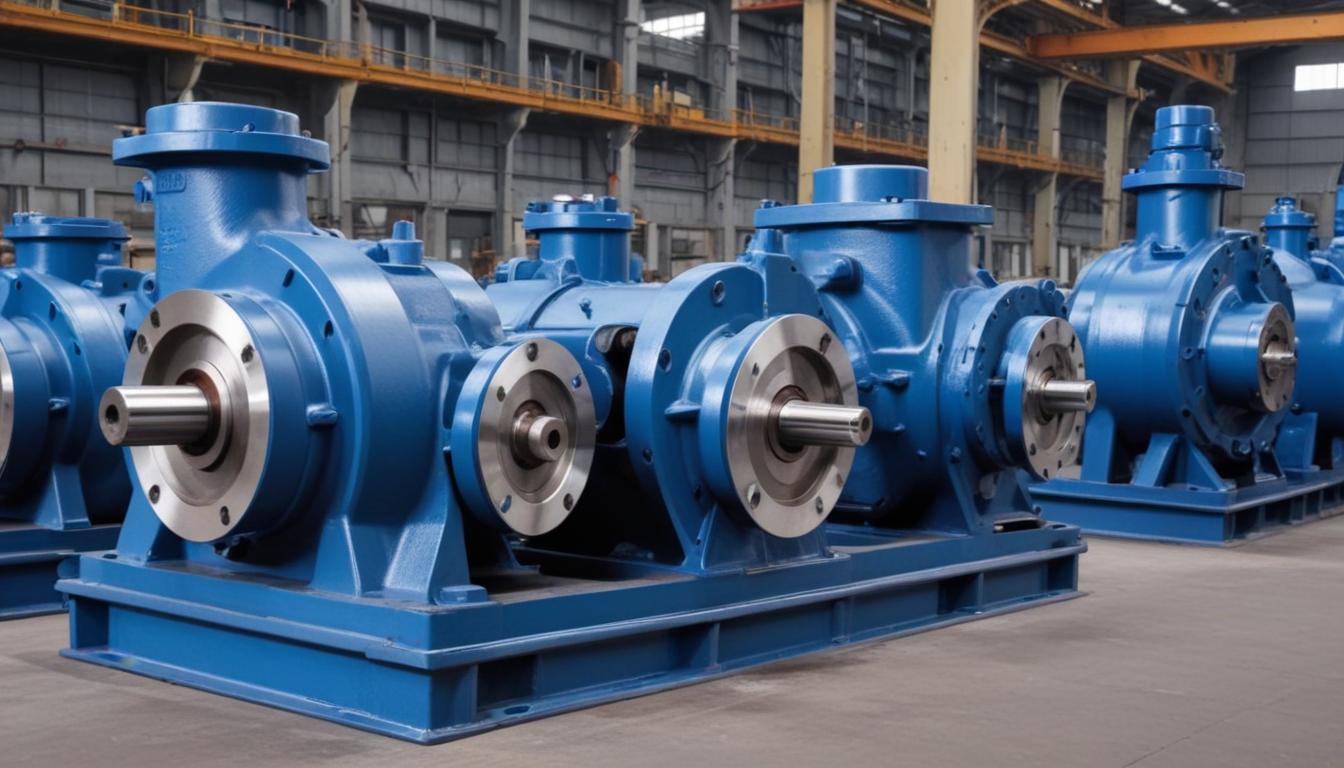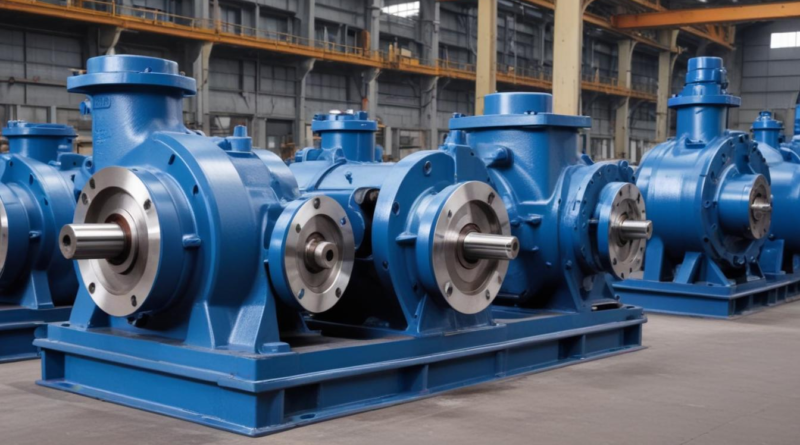the benefits of using gear pumps in heavy industries
Gear pumps play a pivotal role in ensuring efficient fluid transfer within heavy machinery, making them a preferred choice in various industrial applications. Their design facilitates the consistent and reliable movement of fluids, which is essential for the optimal performance of complex machinery systems.
One of the primary advantages of gear pumps is their ability to handle a wide range of viscosities, ensuring smooth operation across different types of fluids. This adaptability is crucial in heavy industries where machinery often operates under varying conditions and with diverse substances.
Key Benefits of Gear Pumps in Efficient Fluid Transfer:
- Consistent Flow Rates: Gear pumps provide a steady and predictable flow, minimizing fluctuations that can disrupt machinery performance.
- High Pressure Handling: They are capable of operating under high-pressure conditions, which is essential for tasks requiring significant force.
- Low Pulsation: The design of gear pumps minimizes pulsation, reducing wear and tear on system components and enhancing overall reliability.
To further illustrate the efficiency of gear pumps compared to other pump types, the following table highlights key performance metrics:
| Pump Type | Flow Rate | Operating Pressure | Efficiency | Suitable Applications |
|---|---|---|---|---|
| Gear Pumps | Consistent and adjustable | High | High | Hydraulic systems, lubrication, fuel transfer |
| Diaphragm Pumps | Variable | Low to medium | Moderate | Chemical handling, abrasive fluids |
| Centrifugal Pumps | High | Low to medium | High for low-viscosity fluids | Water supply, HVAC systems |
Additionally, the integration of gear pumps into heavy machinery systems contributes to overall operational efficiency by ensuring precise fluid control and reducing energy losses. This precision is vital for applications such as hydraulic power transmission, where accurate fluid movement can directly impact the performance and safety of machinery.
Furthermore, the reliability of gear pumps minimizes downtime and maintenance requirements, ensuring that heavy machinery remains operational with minimal interruptions. This reliability, combined with their efficient fluid transfer capabilities, underscores the significant benefits that gear pumps offer to heavy industries.
Enhanced durability and reliability
Gear pumps are engineered to deliver exceptional durability and reliability, making them indispensable in environments where downtime can lead to significant operational losses. Constructed from high-quality materials such as hardened steel, cast iron, and corrosion-resistant alloys, gear pumps are designed to withstand the harsh conditions prevalent in heavy industries. This robust construction ensures that the pumps can endure continuous operation, high pressures, and abrasive fluids without succumbing to wear and tear.
Key Factors Contributing to Enhanced Durability:
- Precision Machining: The components of gear pumps are manufactured with tight tolerances, ensuring minimal clearance between moving parts. This precision reduces the risk of leaks and extends the lifespan of the pump.
- High-Quality Seals and Bearings: Advanced sealing technologies and durable bearings prevent contamination and mechanical failure, maintaining the integrity of the pump under demanding conditions.
- Thermal Stability: Gear pumps are designed to operate efficiently across a wide temperature range, minimizing thermal expansion issues that can lead to component stress and failure.
The reliability of gear pumps is further enhanced by their straightforward design, which minimizes the number of moving parts and potential points of failure. This simplicity not only makes gear pumps easier to maintain but also ensures consistent performance over extended periods.
Benefits of Reliable Gear Pumps in Heavy Industries:
- Consistent Performance: Reliable operation ensures that machinery functions smoothly, reducing the likelihood of unexpected stoppages and enhancing overall productivity.
- Reduced Maintenance Costs: Durable components and reliable operation lead to fewer repairs and less frequent part replacements, resulting in lower maintenance expenses.
- Extended Equipment Lifespan: By maintaining optimal fluid transfer conditions, gear pumps help preserve the integrity of connected machinery, prolonging its operational life.
To illustrate the durability and reliability of gear pumps, consider the following comparison:
| Pump Type | Material Quality | Maintenance Frequency | Operational Lifespan |
|---|---|---|---|
| Gear Pumps | High-grade alloys and hardened components | Low | 15-20 years |
| Diaphragm Pumps | Standard materials | Moderate | 10-15 years |
| Centrifugal Pumps | Varies based on application | Moderate to High | 12-18 years |
In heavy industries where machinery must operate under extreme conditions, the reliability of gear pumps translates to fewer operational interruptions and a more stable production environment. Their ability to maintain consistent performance despite the challenges of heavy-duty applications underscores the significant benefits they provide in terms of both durability and dependability.
Energy savings and operational efficiency
Gear pumps significantly contribute to energy savings and enhance operational efficiency in heavy industries. Their inherent design ensures that energy consumption is minimized while maximizing the performance of industrial systems. By optimizing fluid dynamics and reducing mechanical losses, gear pumps help organizations achieve lower operational costs and improved sustainability.
Energy Efficiency Advantages of Gear Pumps:
- High Mechanical Efficiency: Gear pumps convert a large proportion of input energy into fluid movement with minimal losses, ensuring that most of the energy is effectively utilized.
- Consistent Performance: The steady flow rates provided by gear pumps eliminate the need for overdriving motors to compensate for pressure fluctuations, thereby reducing energy wastage.
- Optimized Pump Sizing: Precision in pump sizing ensures that gear pumps operate within their optimal efficiency range, avoiding the inefficiencies associated with oversized or undersized pumps.
In addition to energy efficiency, gear pumps enhance operational efficiency through their reliable and precise performance. This precision is crucial in applications where consistent fluid delivery is essential for maintaining the integrity of industrial processes.
Operational Efficiency Benefits:
- Reduced Downtime: The reliability of gear pumps minimizes unexpected failures, ensuring continuous operation and reducing the time and costs associated with maintenance and repairs.
- Enhanced Process Control: Precise fluid delivery allows for better control over industrial processes, leading to higher product quality and consistency.
- Integration Flexibility: Gear pumps can be easily integrated into existing systems, allowing for seamless upgrades and scalability without significant disruptions to operations.
To highlight the impact of gear pumps on energy savings and operational efficiency, the following table compares key metrics with other pump types:
| Pump Type | Energy Consumption | Operational Efficiency | Maintenance Requirements | Typical Applications |
|---|---|---|---|---|
| Gear Pumps | Low to moderate | High | Low | Hydraulic systems, lubrication, oil transfer |
| Centrifugal Pumps | High for high-pressure applications | Moderate | Moderate to high | Water supply, HVAC systems |
| Diaphragm Pumps | Variable | Moderate | High | Chemical handling, abrasive fluids |
Furthermore, gear pumps support energy savings through their ability to operate efficiently across a wide range of pressures and flow rates. This versatility allows industries to tailor pump operations to specific process requirements, ensuring that energy is not wasted on unnecessary flow or pressure levels. Additionally, the low pulsation characteristic of gear pumps reduces the strain on other system components, further contributing to energy conservation and extending the overall lifespan of the machinery.
Case Study: Energy Savings with Gear Pumps
Consider a manufacturing plant that upgraded from centrifugal to gear pumps for its lubrication system. The transition resulted in a 15% reduction in energy consumption due to the higher mechanical efficiency of gear pumps. Furthermore, the consistent flow rates improved the overall efficiency of the production line, leading to a 10% increase in output without additional energy input. This case exemplifies how the integration of gear pumps can lead to substantial energy and operational benefits in heavy industries.
By prioritizing energy efficiency and operational reliability, gear pumps offer a compelling solution for heavy industries seeking to optimize their processes and reduce operational costs. The combination of low energy consumption, high efficiency, and minimal maintenance requirements makes gear pumps an invaluable asset in achieving sustainable and efficient industrial operations.
Easy maintenance and installation
 The streamlined maintenance and straightforward installation processes of gear pumps offer significant advantages to heavy industries. Their design simplicity ensures that routine maintenance tasks are easily manageable, reducing the need for specialized skills and minimizing downtime. This ease of upkeep is crucial in environments where operational continuity is paramount.
The streamlined maintenance and straightforward installation processes of gear pumps offer significant advantages to heavy industries. Their design simplicity ensures that routine maintenance tasks are easily manageable, reducing the need for specialized skills and minimizing downtime. This ease of upkeep is crucial in environments where operational continuity is paramount.
Key Features Facilitating Easy Maintenance:
- Modular Construction: Gear pumps are often built with modular components, allowing for quick replacements and repairs without the need for extensive disassembly.
- Accessible Design: The layout of gear pumps ensures that critical parts are easily reachable, enabling faster inspections and maintenance activities.
- Standardized Parts: Availability of common, standardized parts simplifies the procurement process and reduces lead times for repairs.
- Minimal Wear Components: High-quality materials and precise manufacturing reduce the frequency of part replacements, lowering maintenance intervals.
In addition to maintenance advantages, the installation of gear pumps is designed to be efficient and flexible, accommodating various industrial setups with minimal modification. This flexibility is particularly beneficial in large-scale applications where installation time and costs can significantly impact overall project budgets.
Benefits of Easy Installation:
- Flexible Mounting Options: Gear pumps can be mounted in multiple orientations, providing adaptability to different equipment layouts and space constraints.
- Compact Footprint: Their compact size allows for installation in confined spaces, making them suitable for retrofitting existing systems without extensive modifications.
- Quick Setup: Simplified installation procedures reduce the time required to integrate gear pumps into operational systems, accelerating project timelines.
- Compatibility: Gear pumps are compatible with a wide range of piping and hydraulic systems, ensuring seamless integration with existing infrastructure.
To highlight the maintenance and installation advantages of gear pumps, the following comparison table illustrates how they stand against other pump types:
| Pump Type | Ease of Maintenance | Installation Complexity | Downtime During Maintenance |
|---|---|---|---|
| Gear Pumps | Low | Simple and flexible | Minimal |
| Centrifugal Pumps | Moderate | More complex | Higher |
| Diaphragm Pumps | High | Variable | Moderate |
Advantages in Operational Settings:
- Reduced Maintenance Costs: Lower maintenance complexity and fewer required interventions translate to cost savings over the pump’s lifecycle.
- Enhanced Reliability: Easy maintenance ensures that gear pumps remain in optimal condition, maintaining high reliability and performance standards.
- Scalability: The ease of installation and maintenance allows heavy industries to scale their operations efficiently without significant infrastructure changes.
Furthermore, the straightforward installation process of gear pumps facilitates faster deployment in new projects and upgrades, allowing industries to swiftly respond to changing operational demands. This adaptability not only enhances productivity but also ensures that investments in gear pumps deliver long-term benefits with minimal interruptions.
By prioritizing ease of maintenance and installation, gear pumps provide a practical and efficient solution for heavy industries, ensuring sustained operational performance and reducing overall lifecycle costs.
Cost-effectiveness in large-scale applications
Gear pumps offer significant cost-effectiveness in large-scale applications within heavy industries, making them a preferred choice for enterprises aiming to optimize their operational budgets. The initial investment in gear pumps is often offset by their long-term financial benefits, which include lower maintenance costs, reduced energy consumption, and extended equipment lifespan. These savings are crucial for large-scale operations where even minor cost reductions can translate into substantial financial gains.
Key Factors Contributing to Cost-Effectiveness:
- Long Operational Lifespan: The robust construction of gear pumps ensures they remain functional and efficient over extended periods, reducing the frequency of replacements and minimizing capital expenditures.
- Low Maintenance Requirements: Gear pumps require minimal maintenance due to their simple design and durable components. This reduces labor costs and downtime associated with frequent repairs.
- Energy Efficiency: By operating with high mechanical efficiency, gear pumps lower energy consumption, leading to significant cost savings on utility bills, especially in operations with continuous pump usage.
- Scalability: Gear pumps can be easily scaled to meet increasing production demands without substantial additional investment, allowing businesses to grow without incurring excessive costs.
- Reduced Downtime: The reliability of gear pumps ensures continuous operation, preventing costly interruptions and maintaining consistent production levels.
To illustrate the cost-effectiveness of gear pumps compared to other pump types, consider the following comparison:
| Pump Type | Initial Cost | Maintenance Cost | Energy Consumption | Operational Lifespan | Overall Cost-Effectiveness |
|---|---|---|---|---|---|
| Gear Pumps | Moderate | Low | Low to moderate | 15-20 years | High |
| Centrifugal Pumps | Low to moderate | Moderate | High for high-pressure applications | 12-18 years | Moderate |
| Diaphragm Pumps | High | High | Variable | 10-15 years | Low to moderate |
Economic Benefits of Implementing Gear Pumps in Large-Scale Operations:
- Reduced Total Cost of Ownership: The combination of low maintenance, high durability, and energy efficiency lowers the overall cost of ownership, making gear pumps a financially viable option for large-scale operations.
- Improved Cash Flow: Lower ongoing operational expenses free up capital that can be reinvested into other areas of the business, enhancing overall financial health.
- Enhanced Productivity: Reliable and efficient gear pumps ensure consistent production rates, maximizing output without the need for costly overtime or additional shifts.
- Investment in Quality: While the initial cost may be higher than some alternatives, the long-term savings and performance benefits provide a superior return on investment.
Case Study: Cost Savings with Gear Pumps
A leading steel manufacturing plant recently transitioned from centrifugal pumps to gear pumps for their lubrication system. This change resulted in a 20% reduction in energy costs due to the higher efficiency of gear pumps. Additionally, maintenance expenses decreased by 30% owing to the simpler design and fewer required interventions. Over a five-year period, the plant saved approximately $500,000, demonstrating the substantial cost benefits of adopting gear pumps in large-scale industrial applications.
Furthermore, gear pumps contribute to operational flexibility by accommodating varying flow rates and pressures without significant modifications or additional investments. This adaptability ensures that industries can respond to changing production needs without incurring extra costs, further enhancing their cost-effectiveness.
Conclusion:
In large-scale applications within heavy industries, the adoption of gear pumps provides a strategic advantage through their cost-effective operation. The combination of long-term durability, low maintenance requirements, and energy efficiency ensures that organizations can achieve significant savings while maintaining high performance standards. By investing in gear pumps, heavy industries can enhance their financial sustainability and operational efficiency, securing a competitive edge in their respective markets.



